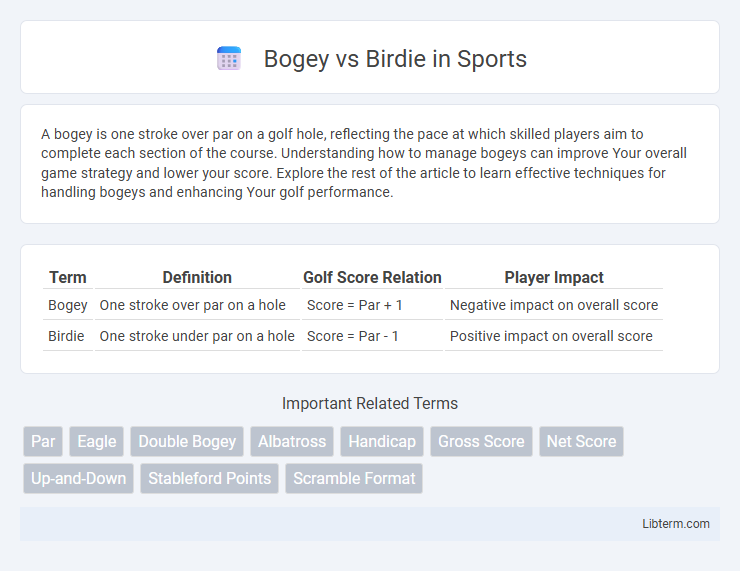A bogey is one stroke over par on a golf hole, reflecting the pace at which skilled players aim to complete each section of the course. Understanding how to manage bogeys can improve Your overall game strategy and lower your score. Explore the rest of the article to learn effective techniques for handling bogeys and enhancing Your golf performance.
Table of Comparison
| Term | Definition | Golf Score Relation | Player Impact |
|---|---|---|---|
| Bogey | One stroke over par on a hole | Score = Par + 1 | Negative impact on overall score |
| Birdie | One stroke under par on a hole | Score = Par - 1 | Positive impact on overall score |
Understanding Golf Terminology: Bogey vs Birdie
In golf terminology, a birdie signifies completing a hole one stroke under par, representing a skilled performance that improves the score. Conversely, a bogey occurs when a player completes the hole one stroke over par, indicating a slightly less favorable outcome. Mastering the difference between bogey and birdie is essential for golfers aiming to accurately track and improve their performance on the course.
The Origin and Meaning of "Bogey
The term "bogey" originated in the late 19th century and was initially used to describe a standard score for each hole, similar to par, but slightly higher. Derived from the British slang word for a "ghost" or "bogeyman," it symbolized an elusive target golfers aimed to avoid surpassing. Over time, "bogey" evolved to mean scoring one stroke over par on a hole, marking a common benchmark in golf scoring.
The Significance of Scoring a Birdie
Scoring a birdie, which means completing a hole one stroke under par, significantly boosts a golfer's score by demonstrating precision and skill, unlike a bogey, which adds an extra stroke over par and can hinder overall performance. Achieving birdies not only improves a player's standing in tournaments but also reflects a strong command of course strategy and shot execution. Birdies contribute to momentum shifts during play, often pressuring competitors and increasing chances of victory.
How a Bogey Affects Your Golf Score
A bogey increases your golf score by one stroke over par on a given hole, reflecting a less efficient performance compared to a birdie, which lowers the score by one stroke under par. Consistently scoring bogeys can significantly raise your total score, making it harder to achieve a competitive round. Understanding how to minimize bogeys while aiming for pars or birdies is essential for improving overall golf performance and lowering your handicap.
The Strategy Behind Achieving a Birdie
Achieving a birdie requires precise shot planning and risk management, focusing on landing the ball close to the pin on the approach shot to set up a makeable putt under two strokes par. Golfers optimize club selection and assess course conditions like wind and green speed to maximize scoring opportunities. Maintaining a confident putting stroke and reading the green effectively are critical elements of the birdie strategy.
Common Mistakes Leading to Bogeys
Common mistakes leading to bogeys often include poor club selection, misjudging distance, and inconsistent swing mechanics. Missing greens in regulation due to inaccurate approach shots increases the likelihood of scoring bogeys instead of birdies. Difficulty in reading greens and improper putting techniques also contribute significantly to adding strokes.
Techniques to Improve Your Birdie Chances
Mastering stroke control and green reading are essential techniques to improve your birdie chances. Prioritize consistent putting by practicing distance control and green speed recognition to reduce strokes. Enhancing approach shot accuracy through focused wedge play and club selection increases birdie opportunities by landing closer to the pin.
Psychological Impact: Bogey vs Birdie on Performance
Scoring a bogey in golf often triggers frustration and self-doubt, negatively affecting a player's concentration and leading to cautious play. In contrast, achieving a birdie boosts confidence and motivation, fostering a positive mindset that enhances focus and consistency on subsequent holes. Studies in sports psychology reveal that these emotional responses directly influence performance, with birdies promoting momentum and bogeys increasing the risk of performance slumps.
Famous Bogeys and Birdies in Golf History
Tiger Woods' iconic birdie on the 16th hole at the 2005 Masters exemplifies clutch performance and precision under pressure. Seve Ballesteros' infamous bogey on the 18th hole during the 1984 Open Championship demonstrated how one stroke can alter the outcome of major tournaments. These moments highlight the significance of birdies and bogeys in shaping golf history and player legacies.
Tips for Balancing Risk and Reward in Golf Scoring
A bogey, scoring one stroke over par, and a birdie, one stroke under par, highlight different risk-reward scenarios in golf strategy. When aiming for birdies, golfers balance aggressive shot-making with precision to avoid costly errors that lead to bogeys. Effective risk management involves assessing course conditions, choosing conservative club selections, and leveraging shot placement to optimize scoring opportunities while minimizing hazards.
Bogey Infographic

 libterm.com
libterm.com